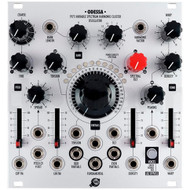XAOC Devices - Odessa
by Brandon Ivers
As Eurorack continues to explore and embrace forgotten forms of digital synthesis, XAOC’s long-awaited Odessa oscillator seems to have come around at just the right time. The Odessa employs an old but underdeveloped form of synthesis known as ‘additive’, where sine waves are added together to create a series of harmonic overtones. It can be hard to wrap one’s head around, but the most primitive version of additive synthesis is the trusty Hammond organ. Not that the Odessa sounds anything like a Hammond, but both use a similar trick: by stacking many sine-like tones on top of each other, you end up recreating the harmonics of more complex, unique waveforms.
The first time I ever tried additive synthesis was on a Kawai K5 years ago, and it felt like discovering some ancient, ultra-sophisticated technology. Glassy, FM-like ambiance is the typical additive sound, but so are noisy, atonal screeches and alien gamelan clangs. People generally tend to associate these sounds with artists like Boards of Canada and other lo-fi atmospheric producers, but in the realm of modular, I think there’s a whole other world of exploration to be had with the Odessa.
First and foremost, the Odessa is quite large at 24 HP. I wouldn’t want it to be any smaller, though, because there are a ton of crucial controls on it that would be horrible if cramped into a smaller space. The main, central knob that’s impossible to miss is for “partials”, which govern how much harmonic density [aka how many sine waves] you want, from 1 to 512. As you turn this knob up, the glassy, icy sound of additive synthesis swells upwards. This ‘partials’ value is CVable, like most other controls on the Odessa, so you can easily modulate the swell. I found just playing with this knob by itself was a good way to kill a couple hours.
Forming a half-circle around the partials knob are controls for spread, tension, bank, harmonic factor, and peaking [with two closely-related controls: density and warp]. The Odessa manual does a fantastic job of outlining how each of these controls works and what they do, as they use a very different technique than your typical subtractive or FM style patch. For example, one of the more dramatic controls is ‘tension’, which moves the components of a harmonic series closer or farther apart. The overall effect creates something akin to noise when the harmonics are close together, and tonal as the components spread apart.
The closest thing to a standard filter on the Odessa are the warp, peaking, and density controls. Together, these create a complex, pitch-relative comb filter that has zero to 256 notches. When used in combination with the ‘partials’ control among others, you can highlight certain partials, allowing you to create sawtooth and square waves and all sorts of other waveforms in between. Other critical controls include exponential and linear FM inputs with attenuators, allowing you to obtain many classic FM sounds when the partials value is set low. There’s also a ‘voices’ button, which allows you to stack one, three, or five voices together. An Odessa expander called ‘Hel’ exploits these multiple voices, effectively giving you a paraphonic oscillator.
Finally, you have three main outputs: even, odd, and fundamental. You can get some unusual, morphing textures by running each output to a modulated VCA, as the outputs mix in interesting ways. A jumper on the back of the Odessa enables you to set the fundamental output as a square wave [rather than sine], allowing for some interesting self-patching ideas for the adventurous.
I’m not trying to sound hyperbolic, but I haven’t heard anything quite like the Odessa before, and that includes the Kawai K5 and software additive synths like NI’s Razor. However, I’m 100% sure that any good additive synth can do any of the sounds that the Odessa can do. So what’s the feat here? One, the controls are really well laid out and easy to understand. Two, this style of synthesis fits very well into modular, making the outer realms of additive a lot easier to explore. Most additive synths in the past have gotten bogged down by clunky interfaces and difficult-to-use modulation, which is not the case here. The Odessa is surprisingly immediate with a ton of sweet spots, and I suspect we’ll be seeing a lot of Eurorack copycats in the future.
24 HP +12V 110mA -12V 80mA Price: $499


